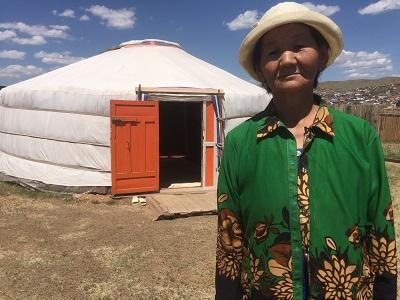
Dorjpagma lost her entire livestock herd during the 2016/2017 Dzud and was forced to migrate to Ulaanbaatar to seek work
By Patrick Fuller
ULAANBAATAR, 1 July, 2018 - Despite decades of rapid socio-economic development, Asia Pacific remains the most disaster-prone region in the world. In 2017 alone, more than 6,500 people lost their lives following more than 200 disasters that affected 66.7 million people.
From 3-6 July, the Mongolian government will host the 2018 Asian Ministerial Conference on Disaster Risk Reduction (AMCDRR) which takes place in the capital Ulaanbaatar. Co-organised with the United Nations Office for Disaster Risk Reduction (UNISDR), the AMCDRR aims to accelerate efforts in the region to reduce and prevent disaster losses through implementation of the Sendai Framework for Disaster Risk Reduction 2015-2030.
Mongolia faces a range of disaster threats including earthquakes, floods, forest fires and drought. One weather-related phenomenon unique to the country is the Dzud, caused by the twin impacts of drought in the summer and severe freezing weather and storms in the winter. One-third of Mongolia's population depends entirely on pastoral farming and the loss of pasture caused by Dzuds, leads to widespread starvation amongst livestock, devastating the herds and livelihoods of nomadic herders.
On the outskirts of Ulaanbaatar lies the suburb of Tahilt. Over the years this informal settlement has grown to accommodate an expanding population of herder families who, having lost their livestock to successive Dzuds, abandoned their traditional lifestyle and migrated to the capital in search of work.
Since her husband died two years ago, 67-year-old Dorjpagma has been living in Tahilt. Her family were amongst the 157,000 herders affected by the 2016-2017 Dzud when more than 1.1 million livestock were lost.
“I had 300 sheep and goats, 30 horses and 20 head of cattle. Most of them died from starvation and the rest were stolen”, explains Doripagma. “Coming to the city was difficult as everything was so costly. Our traditional life was good compared to now. We used to be independent and lived off produce from our animals like milk, cheese and meat. We also produced cashmere wool from our goats”.
In 2018 Dorjpagma left her home in Zavkhan province and travelled 1,000 kilometres to Ulaanbaatar where she found work as a seamstress. Now she survives off a small pension. In her neighbourhood, she continues to remains vulnerable to the impacts of weather-related hazards. A week ago, heavy summer rains cascaded down from the surrounding hills and flooded her Gher (traditional Mongolian tent).
Having worked for Mongolia’s National Emergency Management Agency for 25 years, Namsrai Dumaa is familiar with the social and economic impacts of Dzuds.